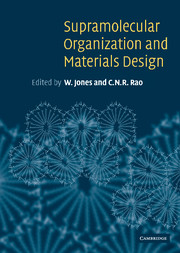Book contents
- Frontmatter
- Contents
- List of contributors
- Preface
- 1 Assembly and mineralization processes in biomineralization: strategies for forming biological composite materials
- 2 Mesoscale materials synthesis and beyond
- 3 Towards the rational design of zeolite frameworks
- 4 Mesoscale self-assembly: the assembly of micron-and millimeter-sized objects using capillary forces
- 5 Design of amphiphiles for the modulation of catalytic, membranous and gelation properties
- 6 Nanofabrication by the surface sol-gel process and molecular imprinting
- 7 The hierarchy of open-framework structures in metal phosphates and oxalates
- 8 Mesoscale self-assembly of metal nanocrystals into ordered arrays and giant clusters
- 9 Layered double hydroxides as templates for the formation of supramolecular structures
- 10 Molecular machines
- 11 Some aspects of supramolecular design of organic materials
- 12 Controlling crystal architecure in molecular solids: the supramolecular approach
- Index
10 - Molecular machines
Published online by Cambridge University Press: 18 December 2009
- Frontmatter
- Contents
- List of contributors
- Preface
- 1 Assembly and mineralization processes in biomineralization: strategies for forming biological composite materials
- 2 Mesoscale materials synthesis and beyond
- 3 Towards the rational design of zeolite frameworks
- 4 Mesoscale self-assembly: the assembly of micron-and millimeter-sized objects using capillary forces
- 5 Design of amphiphiles for the modulation of catalytic, membranous and gelation properties
- 6 Nanofabrication by the surface sol-gel process and molecular imprinting
- 7 The hierarchy of open-framework structures in metal phosphates and oxalates
- 8 Mesoscale self-assembly of metal nanocrystals into ordered arrays and giant clusters
- 9 Layered double hydroxides as templates for the formation of supramolecular structures
- 10 Molecular machines
- 11 Some aspects of supramolecular design of organic materials
- 12 Controlling crystal architecure in molecular solids: the supramolecular approach
- Index
Summary
Introduction
Transistors [ref. 1] are solid state electronic devices capable of amplification and switching operations. By varying an input signal (current or voltage), they are switched reversibly between a State 0 and a State 1. The two states differ in the magnitude of an output signal (current or voltage) that is amplified on going from State 0 to State 1. By interconnecting appropriately several transistors, electronic circuits able to solve logic functions [ref. 2] can be fabricated. The complexity of a logic function and the speed at which it is carried out by an electronic circuit are related to the number of transistors integrated within the circuit. Thus, one of the major goals of the electronic industry is to build ultradensely integrated electronic circuits containing the largest possible number of transistors. This objective can only be achieved by reducing as much as possible the sizes of these switching devices. Indeed, over the past decades the dimensions of transistors have shrunk at an exponential rate and the smallest commercially available transistors have reached micrometer sizes. Stimulated by this tremendous pace toward miniaturization, a number of researchers have envisaged [ref. 3] the possibility of designing and fabricating molecular-sized electronic devices.
- Type
- Chapter
- Information
- Supramolecular Organization and Materials Design , pp. 332 - 362Publisher: Cambridge University PressPrint publication year: 2001
- 5
- Cited by



